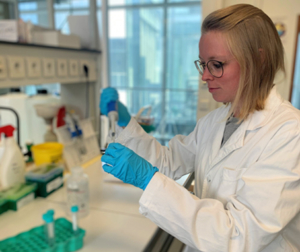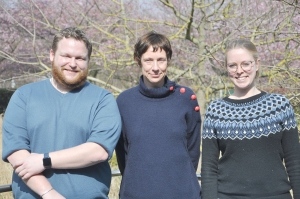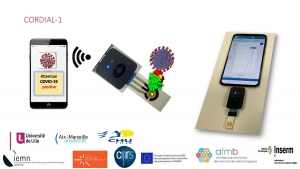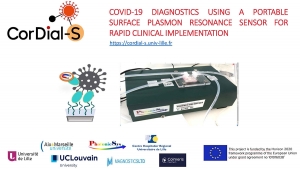Sabine Szunerits (CNRS silver medal) does not like to talk about herself too much, but current events have caught up with her. This sympathetic researcher, full of energy, prefers to insist on the fact that the current success of the CorDial-I and CorDial-S projects is above all the result of rewarded teamwork.
Sabine’s vocation has had a few setbacks that have not affected her determination. She wanted to become a medical doctor, but when it came time to study, her mother refused to let her. She complied but enrolled in a similar field, in pharmacy school. From the start, it was a mixed bag: the lecture hall was full to bursting and she only saw girls among themselves. She crossed the street and found the chemistry lecture hall. There were fewer people and the atmosphere seemed « cooler » to her. From then on, chemistry became her « heart discipline« , with the dream of working in a laboratory.
This dream became true more than fifteen years ago. With a PhD in her pocket from the University of London, she arrived in Grenoble as a CNRS delegate to take up a position as University Professor at the Polytechnic Institute (Grenoble INP) and trained in diagnostics. In 2010, thanks to a job exchange, she joined the University of Lille and the IEMN to work with biologists and physicists. Gradually, she turned to the therapeutic use of nanostructures to inhibit the formation of bacterial biofilms that cause certain infections. Discovering new fields does not scare her. That’s the nature of research:
« You have to feel how far you take the risks. You don’t find anything without risks. You know the project will work, but to get better results, you add risk. The risk is correlated to the time invested and the money you have. »
Covid has pushed Sabine to re-diagnose: « in life, you have to seize opportunities: each one takes you somewhere. One day, maybe you go back to the basics ». The opportunities allowed her to position herself on the double front of therapy and diagnostics; to treat diabetes: in the delivery of drugs through the skin and in the research of a coupling with sensors to measure glucose. From theranostics to CorDial projects, there is only one step …
The two CorDial projects were born from the urgency linked to the appearance of Covid-19 and from a synergy of several actors.
The research on coronaviruses started with the ANR-2018 NanoMERS together with the leading researchers in this field Jean Dubuisson and Karin Seron (Centre d’Infection et d’Immunité de Lille-Institut Pasteur) and was a project dedicated to the use of nanoparticles to inhibit MERS-cell interactions. Orientation towards the detection of SARS-CoV-2 seems almost like natural. Sabine and Rabah Boukherroub (NBI team leader) then found partners willing to invest in this race against time: Alain Roussel from the CNRS Host-Pathogen Interactions Laboratory in Marseille (Nanobodies platform), to develop sensors and David Devos neurologist at the Lille University Hospital, for the clinical protocol.
« Each discipline complements the other well. In research, we can’t work without the others. We were ready to go for it; we worked like crazy! «
Thanks to this efficient teamwork, the CorDial-I application was quickly selected by the I-ISITE-Université Lille Nord Europe Task Force, which dedicated a sufficient amount of funding for Covid-19 research activities is responsible for organizing research activities on the Covid. From April 2020, a collection of samples is set up, drawing a real human and scientific chain. The Lille team quickly received samples from Marseille and after six weeks, the first results appeared: the electrode responded well to the detection of the Spike protein – which clings to the human cell to infect it – and the clinical trials for the pre-tests were very encouraging. A patent was then drafted and the project was matured by Satt Nord (in co-maturation with Satt Sud-Est), with a budget allocated over two years.
In July, the first conclusive tests took place with samples of real viruses from the hospital. At the same time, as part of the European Horizon 2020 framework program, Sabine contacted Ibrahim Abdulhalim, (CEO of PhotonicSys, an Israeli company) who was working on a portable version of SPR (Surface Plamonic Resonance) to set up tests. Normally for the SPR, we use big machines but here it is a light version of less than 1 kg, which fits almost on an A4 sheet of paper, that we can carry.
The result: an inexpensive, portable device that measures 6 to 8 samples simultaneously for reliable results in 30 minutes!
The creation of a startup CorDial-IT (Intelligence Technology) on the Eurasanté site is planned for 2021, with the help of Quentin Pagneux, Sabine’s former Master’s intern, currently involved in the NanoMERS project. The startup will expand the development of sensors to other viruses such as influenza and design biomarkers in blood to detect neurodegenerative problems related to Alzheimer’s disease. And this with the same trio of researchers: you don’t change a winning team!
 Léa Rosselle, in her third year of doctoral studies, is benefiting from a Cifre thesis financed by the TissueAegis startup in Paris, which specializes in the transport of corneas for transplants. A gentle and discreet young woman, she nevertheless knows what she wants, as Sabine Szunerits, her thesis director, explains: « She waited patiently for several months after a Cifre thesis to be able to work in R&D. » With a Master’s degree in Biotechnology, Léa has done internships in France, Sweden and Norway in biochemistry and cell biology. « In her master’s degree, Sabine introduced me to nanomaterials and their applications in medicine. These courses opened up a lot of perspectives for me. »
Léa Rosselle, in her third year of doctoral studies, is benefiting from a Cifre thesis financed by the TissueAegis startup in Paris, which specializes in the transport of corneas for transplants. A gentle and discreet young woman, she nevertheless knows what she wants, as Sabine Szunerits, her thesis director, explains: « She waited patiently for several months after a Cifre thesis to be able to work in R&D. » With a Master’s degree in Biotechnology, Léa has done internships in France, Sweden and Norway in biochemistry and cell biology. « In her master’s degree, Sabine introduced me to nanomaterials and their applications in medicine. These courses opened up a lot of perspectives for me. »
Her thesis topic is in the biomedical field: « transdermal drug delivery on demand for the treatment of chronic wound infections. « With a keen interest in the intersection of chemistry and biology, our doctoral student deploys her research in two fields.
The design of dressings that heal. Transdermal delivery via patches provides local benefits without the treatment passing through the digestive system or the protocol being invasive. The patches, more advanced than a simple bandage, stimulate the healing mechanisms and allow the bacterial shield to be attacked.
Testing the effectiveness of dressings. Cellular cytotoxicity tests and ex vivo pre-tests are performed using biological experiments that mimic the clinical conditions of wound healing. Because it is difficult to find suitable laboratory models to test the patches because the wound healing process varies among mammals, the tests are performed on human skin collected from hospitals.
« There is still some lack of awareness of the use of hospital waste for research. However, chronic wounds pose major health problems involving heavy management. Moreover, the diagnosis of the degree of severity of chronic wounds is still often subjective. In the future, we could imagine an intelligent dressing that would connect all disciplines. »
A stimulating perspective for our doctoral student whose eyes sparkle! Léa is very committed to her work, as Sabine testifies: « It’s a great pleasure to work with her, both in the exchanges on research projects and in the keeping of protocols. » But, like any passionate person, our young researcher is aware of her small shortcomings but sets herself challenges to overcome them. Thus, in 2020, the presentation of her « thesis in 180 seconds » allowed her to win the 2nd prize at the regional final of this competition which takes place every year. For her thesis director, « Léa is very independent and capable of bringing progress to her work because she knows how to evaluate and control the risks she undertakes. » These are undeniable assets for research!
Writing : Karine Perrot (department Éditions-Communication-Multimédias from IEMN)

















